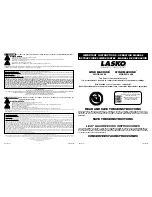
Operating instructions
D4E225-CC01-02
Translation of the original operating instructions
4. CONNECTION AND START-UP
4.1 Connecting the mechanical system
CAUTION
Cutting and crushing hazard when removing blower
from packaging
→ Carefully remove the blower from its packaging by grasping
hold of the housing. Never subject to impact.
→ Wear safety shoes and cut-resistant safety gloves.
CAUTION
Heavy load when taking out the device
Bodily harm, e.g. back injuries, are possible.
→ Two people should remove the device out of its packaging
together.
NOTE
Damage to device from vibration
Bearing damage, reduced service life
→ Forces or impermissibly high vibration levels must not be
transmitted to the fan from system components.
→ If the fan is connected to air ducts, it should isolated from
vibrations, for example using compensators or similar
elements.
→ Fasten the fan to the substructure without distorting it.
;
Check the device for transport damage. Damaged devices must no
longer be installed.
;
Install the undamaged device according to your application.
CAUTION
Possibility of damage to the device
Serious damage may result if the device slips during assembly.
→ Keep the device fixed in position at the installation location
until all attachment screws have been tightened.
●
The fan must not be strained on fastening.
4.2 Connecting the electrical system
DANGER
Electric voltage on the device
Electric shock
→ Always install a protective earth first.
→ Check the protective earth.
DANGER
Incorrect insulation
Risk of fatal injury from electric shock
→ Use only cables that meet the specified installation
requirements for voltage, current, insulation material, load etc.
→ Route cables such that they cannot be touched by any
rotating parts.
DANGER
Electrical load (>50 µC) between mains wire and
protective earth connection after switching of the supply
when switching multiple devices in parallel.
Electric shock, risk of injury
→ Make sure that sufficient protection against accidental contact
is provided.
Before working on the electrical connection, the
connections to the mains supply and PE must be shorted.
CAUTION
Electrical voltage
The device is a built-in component and features no electrically
isolating switch.
→ Connect the device only to circuits that can be switched off
using an all-pole disconnecting switch.
→ When working on the device, you must switch off the
system/machine in which the device is installed and secure
it from being switched on again.
NOTE
Water penetration into leads or wires
Water enters at the cable end on the customers side and can
damage the device.
→ Make sure that the cable end is connected in a dry
environment.
Connect the device only to circuits that can be switched off
using an all-pole disconnecting switch.
4.2.1 Prerequisites
;
Check that the data on the type plate match the connection data.
;
If the operating capacitor is not installed by ebm-papst, check whether
the data of the operating capacitor match the data on the type plate.
;
Before connecting the device, ensure that the supply voltage matches
the operating voltage of the device.
;
Only use cables designed for current according to the type plate.
For determining the cross-section, follow the basic principles in
accordance with EN 61800-5-1. The protective earth must have a
cross-section equal to or greater than the outer conductor cross-
section.
We recommend the use of 105°C cables. Ensure that the minimum
cable cross-section is at least
AWG26/0.13 mm².
Protective earth contact resistance as per EN 60335
Compliance with the resistance specifications as per EN 60335 for the
protective earth connection circuit must be verified in the application.
Depending on the installation situation, it may be necessary to connect
an additional protective earth conductor by way of the extra protective
earth terminal provided on the device.
4.2.2 Voltage control
NOTE
Excessive current may occur with speed control using
transformers or electronic voltage regulators (e.g. phase angle
control). In addition, depending on how the unit is installed,
noise and vibration can occur with phase angle control.
Vibrations can lead to bearing damage, which can lead to
premature failure.
Heating-up of the motor when using voltage control must be checked by
the customer following installation in the end device.
Item no. 10979-5-9970 · ENG · Revision 228992 · Release 2021-02-24 · Page 6 / 11
ebm-papst Mulfingen GmbH & Co. KG · Bachmühle 2 · D-74673 Mulfingen · Phone +49 (0) 7938 81-0 · Fax +49 (0) 7938 81-110 · [email protected] · www.ebmpapst.com





























